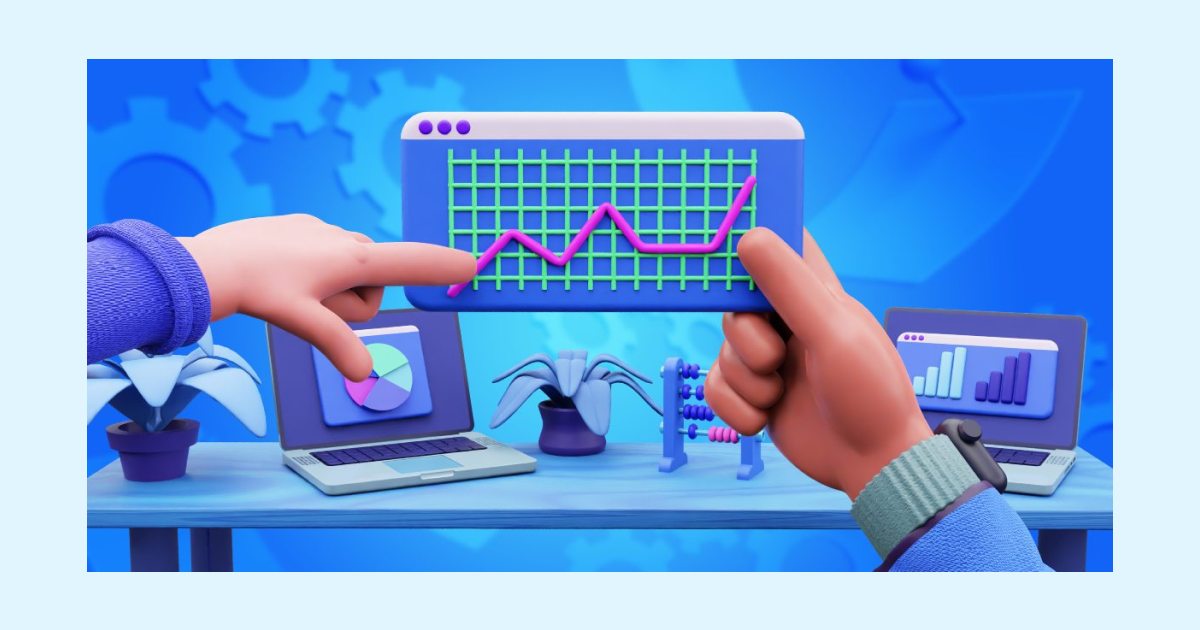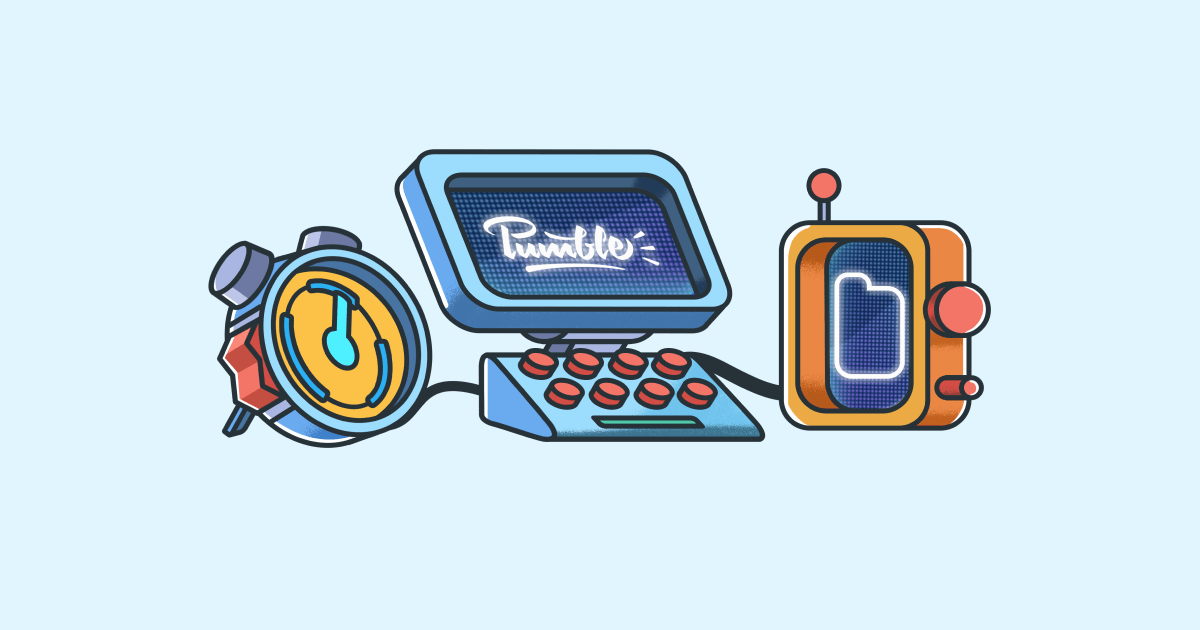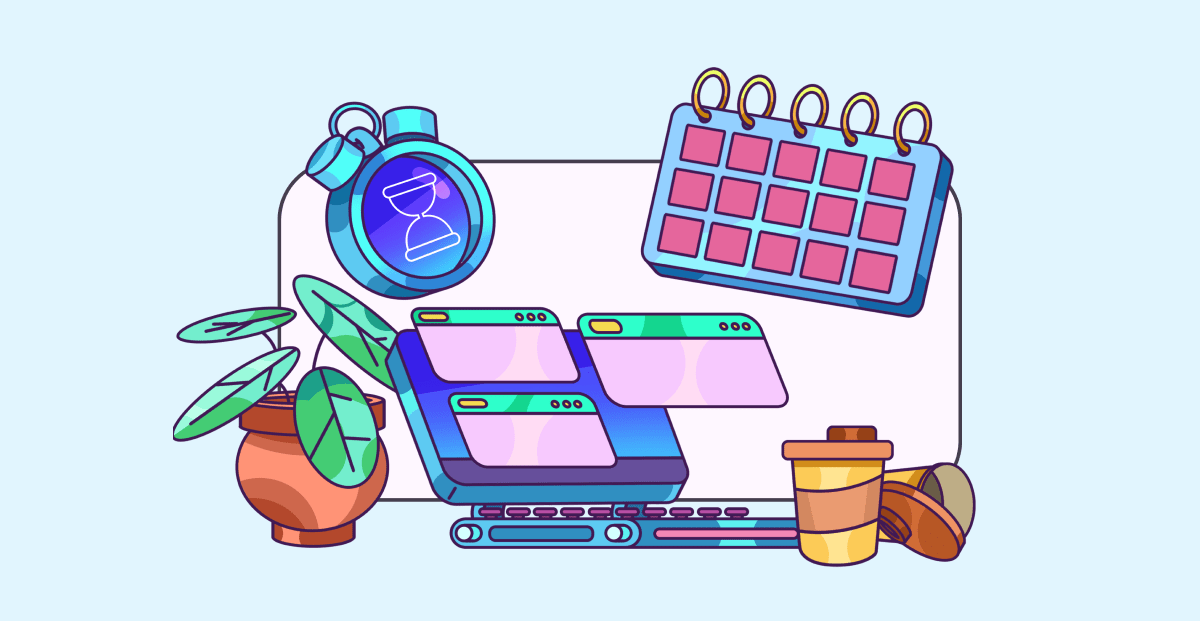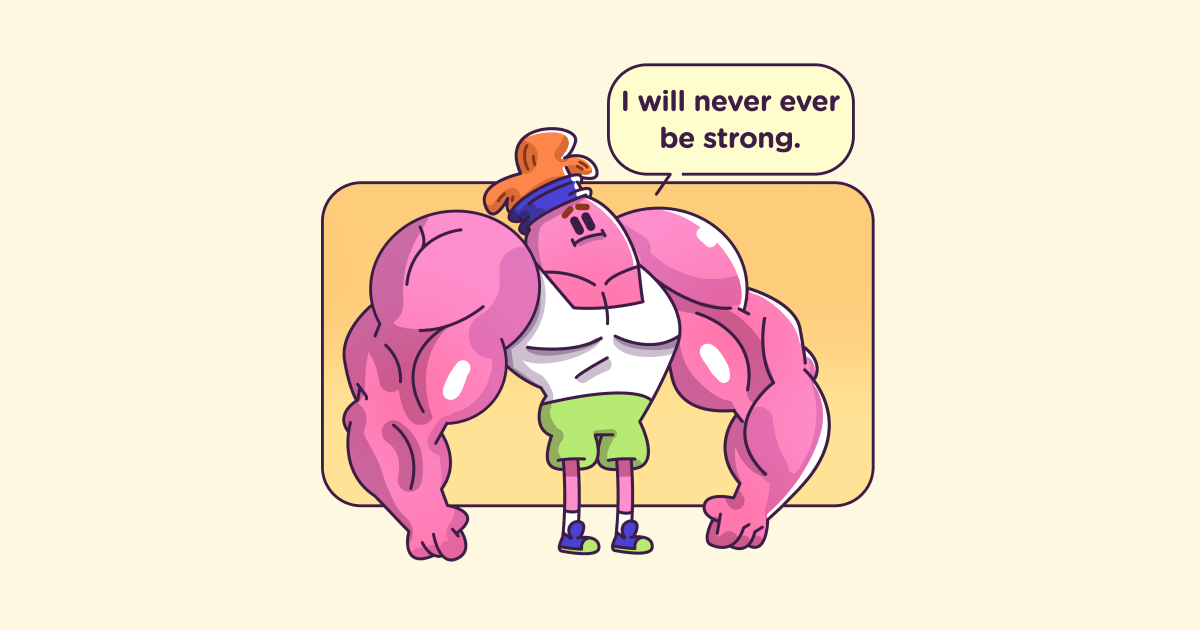30+ Time management tips for freelancers
Last updated on: December 15, 2022
Working as a freelancer has its fair share of challenges, as you have to perform many tasks that are usually not a one-person job.
Some of the issues you might have to deal with if you decide to work as a freelancer include:
- Running your entire business,
- Managing and parsing your workload,
- Setting all your schedules, and
- Communicating and cooperating with clients regularly.
For these and many other reasons, time management for freelancers has become the new buzzword. Apart from the above-mentioned challenges, you’ll also have unique issues to address, such as:
- Avoiding home distractions, and
- Adapting a part of your home to serve as your workplace.
However, if you consider these points, you’ll be able to manage your time in the best possible way and stay productive and committed to your work.
For more clarity on how to make the most out of your time working as a freelancer, this in-depth article will let you in on how to:
- Manage your time and stay afloat with your workload,
- Choose the ideal work setting, and
- Use cool tools to help you with your freelancing!
To make your work life less taxing, I included beginner, advanced, and additional freelancer tips. So, without further ado, let’s get into it!
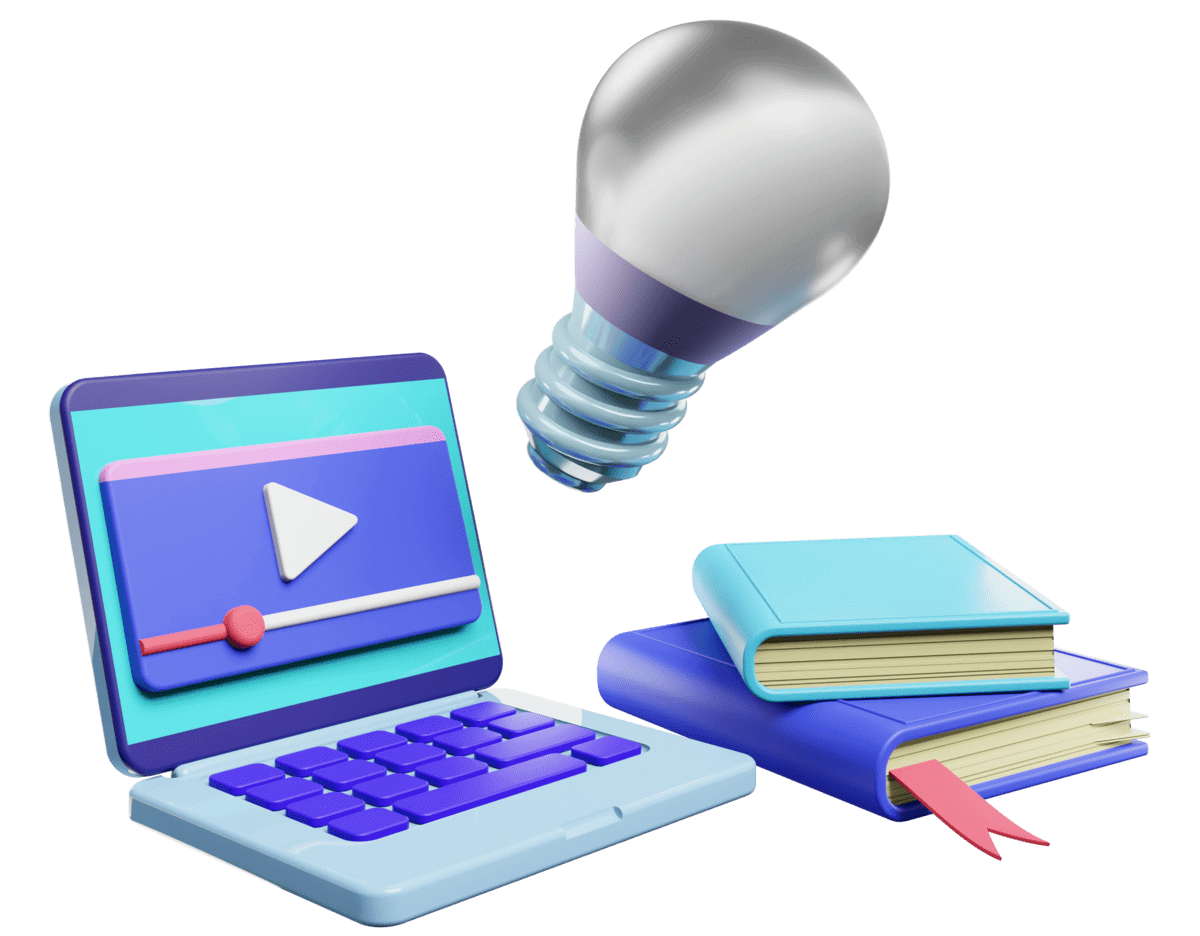
Table of Contents
Freelancing tips for beginners
As soon as you get into the business, you’ll want to earn some money — and you’ll probably want to earn it fast!
But how do you actually do that, and what type of freelancing is best for beginners?
I’m glad you asked!
Here are some time-tested tips on freelancing.
Tip #1: Find out what you’re good at
For starters, you need to learn what makes you tick.
In other words, ask yourself what skills you feel confident about. Are you a good writer, designer, programmer, or HR specialist? Perhaps you aren’t that good, but you feel like you could get better over time.
For starters, I recommend taking a skills test and learning more about your professional shortcomings. Only then can you know which gaps to close.
For orientation, here’s a quick summary of the biggest niches in the freelancing business:
- Art and design,
- Digital marketing,
- Education,
- Travel,
- Accounting,
- Health and wellness, and
- Entertainment.
Does any of this sound like you? If you have a computer and accompanying software, nothing can stop you!
Tip #2: Get to know your industry
First of all, birds of a feather flock together. This is the case with freelancers, too. In other words, you should get on board with people who have similar interests in your industry.
To do that, try finding platforms, forums, and websites with individuals from your branch. There you can see how they handle their unique (and not-so-unique) challenges and learn where to get your first gig!
Speaking of the first gig, you need to learn more about your future clients. Yes, other freelancers can help you understand your industry better. However, you’ll need to research your clientele on your own, learning about your preferences in the process.
To start, ask yourself a few questions:
- How much do I expect to be paid?
- Who’s willing to pay me that?
- Where do these people hang out?
- What’s the easiest way to reach them?
Tip #3: Create an online portfolio
Thirdly, I warmly suggest getting yourself an online portfolio or website. There, you can showcase your work and services. Also, having a ready-made showcase of your work will make you look professional to potential clients.
Bonus tip: Stand out by upping your LinkedIn game. Simply put, this means:
- Uploading a professional image,
- Adding all applicable sections, like education and work experience,
- Populating your description,
- Posting regularly to gain traction, and
- Getting in touch with people from your industry.
Tip #4: Find your most productive hours
Fourthly, but not least important for beginner freelancers, I suggest finding your most productive hours. Doing so allows you to create your schedule around those peak periods and get the maximum out of your workday.
To learn more about peak productivity windows, I sat down with Max Wesman, COO at GoodHire. Max brings home the point by saying that freelancers have so much freedom that it can sometimes work against them.

“Without any need to follow a routine, it’s easy to become disorganized or fall behind on your work. Therefore, it’s essential to be strict with yourself by setting a sensible schedule. The main benefit of freelancing is that your scheduling method is entirely up to you.“
Max suggests that no two persons are the same, freelancers included. In fact, he says that some people prefer to do the bulk of their work early in the morning. In contrast, others prefer to set deep focus work windows twice a day, when it suits them best. To conclude, Max adds:

“As the day draws to a close and your energy tapers off, you can maintain a productive flow by directing your attention towards easier or more menial tasks. For night owls, the same works in reverse. Start your day with quick, easy wins before following into your most difficult tasks in the evening.”
Congrats — you’ve got the basics out of the way. So, let’s now jump into some more advanced techniques and additional tips!
💡 Clockify Pro Tip
To get geeky about peak productivity hours, check out this in-depth article that explains it all:
Advanced freelancing tips
Now that we’ve got the foundational stuff behind us, let’s look at freelance advice for those who want to make themselves even productiver. Yup, I just invented a new word!
For this section on tips for freelancing, we’ll dive deep into time-tested guidance on how to show up for yourself. This means being the best person you can be, both professionally and personally. In turn, such a mindset allows you to show up for others, including your clients, coworkers, and family.
Tip #1: Become mentally tough
Let’s start with resilience, the buzzword of the 2020s. It’s closely knit with productivity and burnout, as many of us learned the hard way.
Imagine a deadline approaching, and you must invest extra effort into completing a job assignment. It may seem intuitive to simply sit down, put in the work, and get it done. But that’s a suboptimal approach to the issue.
In fact, strenuous work inevitably leads to burnout and creates an unhealthy relationship with your job. Instead, resilience experts suggest:
- Tending to your needs and feelings,
- Creating structure in your workday,
- Introducing routines, like reading and meditation, and
- Being proactive with your problems.
As a bonus tip, I recommend doing a morning pages routine every day. It simply involves writing down everything that pops into your mind for 10 minutes first thing in the morning. This technique helps remove mental clutter and makes your mind sharper for the rest of the day.
Tip #2: Work in short bursts
Imagine yourself energized and ready to tackle all the work challenges life has in store for you. So you sit at your desk — or stand up — and start plowing through. You reach your 60-minute threshold at one point but keep working with plenty of eagerness to maximize the momentum.
Suddenly, you crash badly and feel sluggish for hours. What you didn’t know is that this may result in hardcore burnout if you work in this manner for days.
To counteract this harmful work style, I suggest working in short bursts. This means allotting short sessions of 30 or 60 minutes of work, followed by 10-minute breaks. For this purpose, you can use a phone timer or the Pomodoro technique.
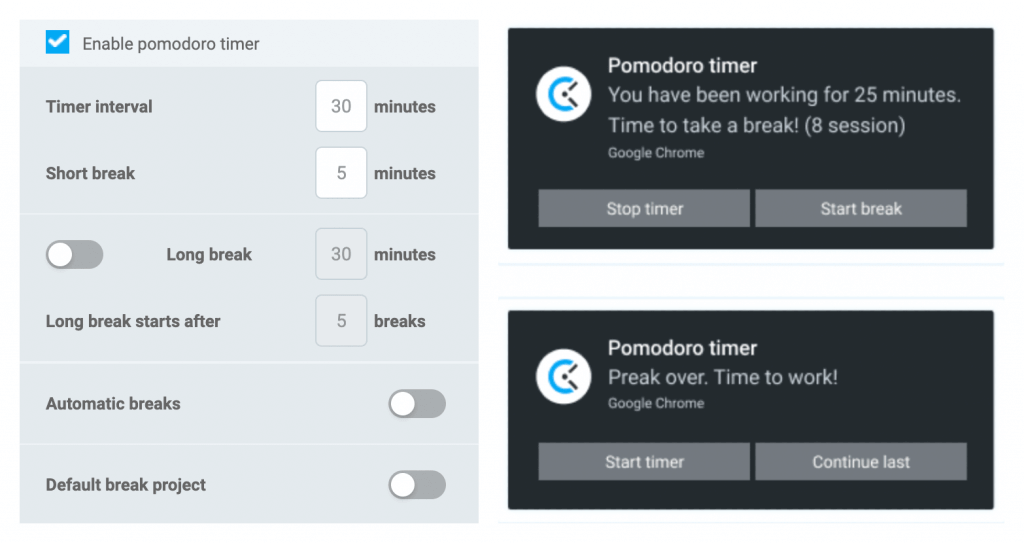
It’s an easy concept to grasp, as it means you:
- Work for 25 minutes,
- Take a 5-minute break, and
- Repeat.
After four sessions, you can take a longer break of 20 or more minutes. And that’s it!
Tip #3: Remember a Zen koan
When you’re in the middle of your work and suddenly realize you’ve been overwhelmed, you may want to turn to some ancient wisdom. For example, I sometimes use Zen koans, which help me re-center and return to work refreshed.
A koan is a statement, short story, or question that helps you uncover great truths about yourself and the world. Often, they spark curiosity and interest in everyday affairs, including your work. For illustration, here’s an example of a koan: What is this?
Asking this question out loud may reveal some hidden beauties or things to be grateful for in your life. In fact, it will often help you return to your job feeling refreshed. When I ask this question, even silently in my head, it increases my life satisfaction and casts my mind into a positive state.
It takes seconds to do it, so try it out once a day for weeks for maximum benefits!
Tip #4: Regulate your information intake
We consume plenty of news every day, both on social media and in traditional outlets. So much so that one study suggests that US citizens will spend around 13 hours daily interacting with media in 2022.
All this information intake does something to your brain. It clouds your judgment and disrupts your mental clarity, leading to a subpar performance at work. Therefore, to avoid the harmful consequences of too much information, try regulating what gets into your most precious asset — your mind. And yes, please be ruthless about it!
Tips for adapting your workspace
Freelancers work away from a typical office setting. Yet, that doesn’t mean you shouldn’t dedicate and adjust an area in your home for work.
Actually, there’s ample reason to suggest you should do just that.
So, let’s learn more!
Tip #1: Choose the ideal work setting
You may feel tempted to work from bed. After all, working from bed is a comfortable, cozy solution. But it’s actually a harmful one.
According to Emine Saner from the Guardian, working from bed hampers your sleep quality because you’ll stop viewing your bed as a place for rest. Although you probably already knew that, you do need rest to perform your work productively.
If you live in a small apartment, make sure to pick a corner to set up for work. You can choose a smaller desk and chair and invest in headphones to block out background noises and the TV — especially if you don’t live alone.
Overall, the best practice is to pick a room with no television and with a reliable internet connection. You’ll also need a sturdy table and a comfortable chair since you’ll probably be spending eight hours per day in your newly set home office from now on.
Tip #2: Pick your desk carefully
To start, keep in mind that some experts claim that standing desks can be harmful to your health.
Yet, that’s only one side of the coin. The other is that recent research shows how standing at work may reduce the risk of back and shoulder pain.
Similarly, a study by the European Journal of Preventive Cardiology discovered that standing for six hours a day helps people shed pounds and prevent weight gain.
In contrast, this study shows that sitting for prolonged periods is linked with a higher risk of:
- Obesity,
- Cardiovascular disease,
- Diabetes, and so on.
But everything comes with a caveat, and so does this. In fact, standing for long periods can cause foot and leg pain, to mention a few. As you might expect, the catch is to find a middle ground!
Also, a study from the National Center for Biotechnology Information implies that it’s better to mix it up. In other words, sit for an hour and then stand for an hour.
I know that most advice for freelancers seems straightforward. Well, this one isn’t and you should avoid going to extremes for either!
Bonus tip: Try not to alternate from one mode to another abruptly. Instead, you should slowly adjust to this mixed manner of working — and not jump from sitting for five hours to standing for five hours. It could hamper your productivity and health in the long run.
💡 Clockify Pro Tip
Want to learn about optimal ways to work as a freelance team from home? Well, then you’re in for a ride if you check out this article:
Tip #3: Switch locations
You aren’t tied down to your home office or living room. In fact, a change of scenery often results in higher productivity and better outcomes.
Brie Reynolds, a senior career specialist at FlexJobs, told Business Insider that moving from space to space is helpful to “stay focused and productive throughout the day.”
Some examples of alternative work environments include:
- Coworking spaces,
- Coffee shops, and
- Virtual settings with friends or coworkers.
As a matter of fact, even switching from room to room within your home can still yield vast benefits. Wherever you work, try to mix things up occasionally and check where you’re most productive.
Lastly, get as comfortable as possible. But beware: there is such a thing as too comfortable, so try not to work on a sofa.
Tip #4: Include some colors and plant life
One of the factors you should have in mind is the predominant colors in your workspace. Curiously, they have an influence on your productivity. Bear in mind there is no right or wrong color palette, as it mostly depends on the individual.
However, experts on neuroscience suggest that:
- Blue is a color of stimulation,
- Orange is conducive to decision-making, and
- Green is spectacular for focus.
Likewise, adding some plants to your space designated for work is also a great idea because green plants make employees more comfortable. In turn, comfort ups their productivity, so it will improve yours as well.
Tip #5: Adjust the lighting
We’ve known for a while that poor lighting results in fatigue, eye strain, and stress. On the other side of the spectrum, too much light can similarly cause health problems. As always, the trick is to find the soft spot.
To that end, make sure you adjust the lighting in your work area:
- Bring in as much natural lighting as possible during the day. It’ll improve your work performance, according to a study by researchers at Northwestern University in Chicago. The reason is that natural lighting enhances your sleep quality and overall vitality. If you can’t bring in natural lighting, LED is an effective alternative.
- Remember that you’ll also need dedicated lighting. Lamps are never a bad idea, especially when you’re working late at night. However, if you decide to go for LED lighting, keep in mind that it might disrupt your sleep pattern since it imitates natural lighting. When choosing the type of light, just remember that the National Institute for Occupational Safety and Health asserts that cold light is best to make you alert. As icing on the cake, cold light also decreases fatigue.
Tip #6: Ensure you have a spot for relaxation
Suppose you have an entire room for your work and not just a corner.
In that case, you can pick a spot to relax and unburden during breaks. This can be a comfortable sofa or a chair beside the window. As a result, you’ll learn to associate this spot with relaxation, and it’ll be comforting to know that not everything in the room is linked to your work.
As soon as you feel your job is becoming too much to handle, but you also feel that you don’t want to take a longer break, just go to your chair or sofa. There you can sit quietly for a minute or two or meditate and then return to your work refreshed.
Tips for avoiding home distractions
Distractions are bigger threats to freelancer productivity than that of full-time employees because there isn’t a traditional office setting to keep you in check. Luckily, there are a few tips for freelancers to help you out with that!
Tip #1: Cut down on your phone, social media, and internet use
When surrounded by colleagues, you’re less likely to procrastinate on the internet or dabble with your phone, as your colleagues’ mere presence makes you more aware of what you’re doing. But, freelancers usually work alone. So, they have no one but themselves to make them accountable for their procrastination.
A great solution for your phone would be to turn it off and leave it far from reach so that you’re not constantly tempted to check it.
As for avoiding social media during work hours, you can try a website blocker for your browser or device and add all the websites you’ll want to block yourself out from during this period.
For example, if you’re a Mac user, you can try out SelfControl. Other users swear by Freedom.
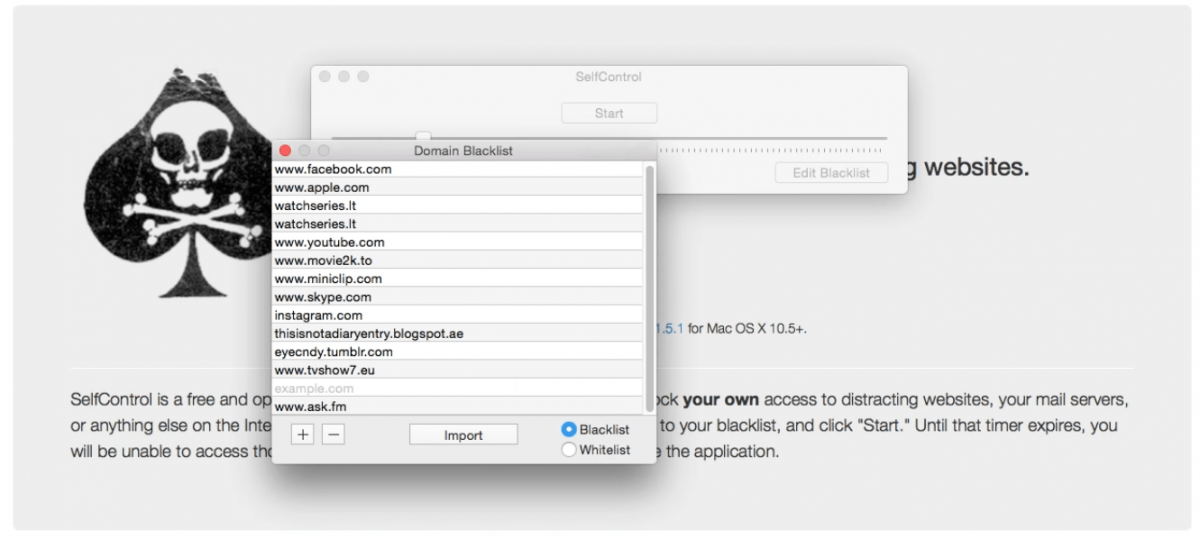
If you want to make yourself more accountable with your work, you can try out FocusMate. In a nutshell, you are assigned a partner to whom you can explain your task for the day and then work silently on it. This way, you’ll simulate a real office setting and make use of another person’s presence to make sure you don’t procrastinate.
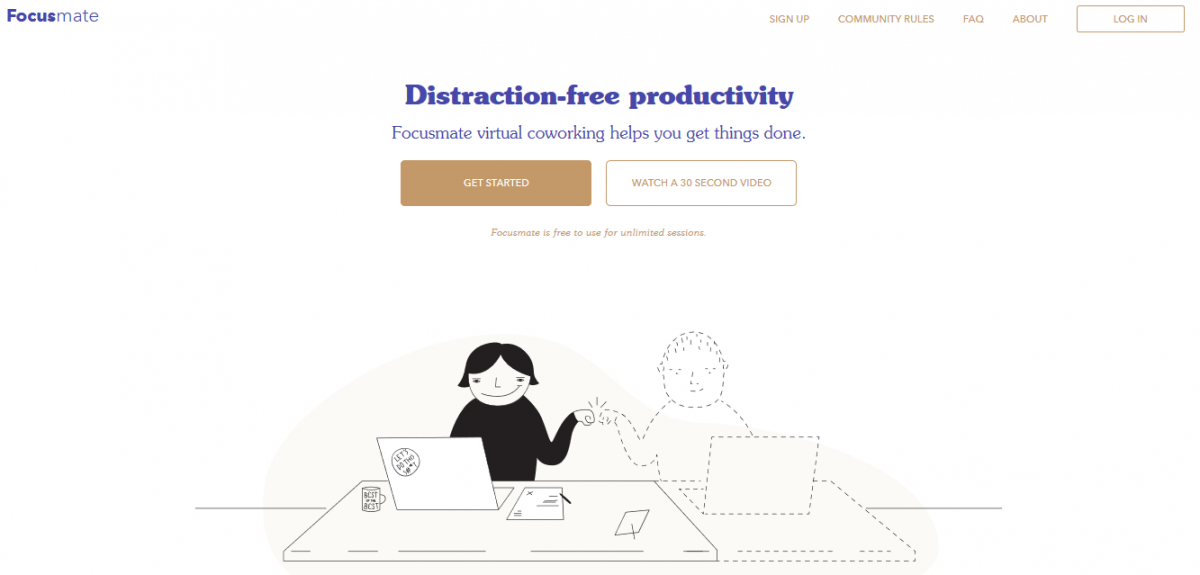
Tip #2: Manage background noises
Freelancer workers face bigger problems than full-time workers in terms of background noise because they work in a home setting.
As a result, family, TV noise, and pets are usually a part of their every day during work hours. As random conversations with family members or being distracted by a pet undermines your focus, you’ll have to make some adjustments and take precautions.
To start off, it’s best that you work in an isolated room. But whether that is an option for you or not, tell your family members to act as if you’re physically away during your work hours. Pick out some headphones and use them to indicate that you’re focused on work. Once you put them on, others will know you don’t want anyone to disturb you.
Interestingly, you can select some music to listen to while working, as it helps drown out background noises. In fact, there are some types of music that science claims can also enhance your focus. So, let’s explore a few.
Listen to game soundtracks
The purpose of a game soundtrack is to immerse you in a game. Logic tells us that listening to these soundtracks while working will help you immerse yourself in work. There are several online radio stations that only play game music, and you can try out VGM radio.
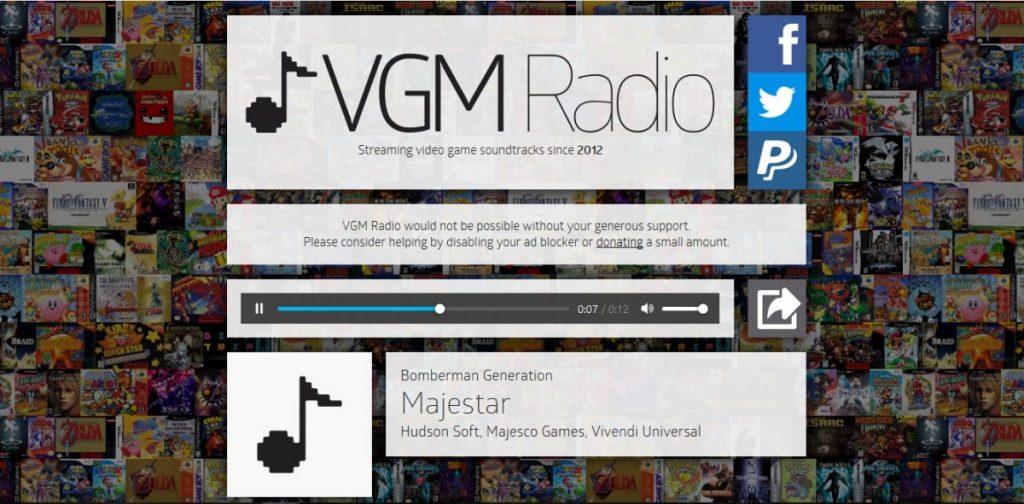
Tune into instrumentals
Instrumentals are always a better option than tunes with lyrics, at least for some types of work.
Suppose you’re a designer. In this case, music with lyrics likely won’t avert your attention. However, listening to words in songs will probably distract you from your writing if you’re a writer. The reason is that you’ll be trying to interpret what you hear, which could affect your writing.
There are a lot of longer instrumental pieces you can listen to on YouTube, such as this one. Alternatively, you can immerse yourself in classical music, like that of Mozart.
What has become known as the “Mozart effect” stems from a situation when students did a test after listening to Mozart’s sonata for two pianos in D major K488. In fact, some psychology researchers suggest that it increases spatial reasoning, which is tied to problem-solving and out-of-the-box thinking.
💡 Clockify Pro Tip
What music fits your work mode? We’ve researched this topic extensively and we bring you the gist of it right here:
Listen to ambient noise generators
If you find that you’re more likely to focus when listening to ambient noise and nature sounds, you should try an ambient noise generator. There are various apps that offer an array of sounds, the most common ones being the sounds of:
- Crackling fire,
- Babbling brooks,
- Wind, and
- Café chatter.
At any rate, you can choose what works best for you. For example, if you find the sound of falling rain in various seasons helps you concentrate the most, you can visit Rainyscope.

Tips for creating a freelance routine
I’ve heard this question many more times than I can remember: How do I organize my day as a freelancer?
Well, setting up and sticking to a routine is the best way to plan out your workload. It allows you to make sure you minimize stressful situations and adhere to all deadlines. To help you out with that, we’ll give you a rough blueprint shaped in the form of a couple of tips.
Tips to follow before the workday
Most freelancers feel discouraged by the endless to-do list just when the workday starts. But here’s a short lineup of things you can do to nip the workload in the proverbial bud:
- Lay out all the tasks you have to do the evening before.
- Prioritize your tasks and decide what is your most important one for the day. You’ll aim to tackle this task first thing tomorrow, which is called “eating your frog.”
- Create an hourly schedule for your day.
- Leave some flexible time in your schedule for unexpected errands and assignments.
- Plan your meals for tomorrow. This way, you won’t have to waste time figuring out what you’ll eat when hunger strikes.
- Go to bed early so that you get at least seven to eight hours of sleep. And no, there’s no workaround for this one!
💡 Clockify Pro Tip
Speaking of beds, do you want to know more about the first thing you should do in the morning? Read our article on this topic:
Tips to follow during the actual workday
It often feels tempting to jump right into work mode from bed or the morning shower. But do you really know what you should do first thing in the morning? If you’re like most remote workers, you may be yanked around by a slew of priorities fighting for your attention.
Luckily, we’ve got the antidote!
- Wake up early. Depending on whether your productive peak hours are in the morning or not, you can use this time to work on the most important tasks for the day or ease into the day with some exercises and less burning issues.
- Have breakfast before engaging in any serious work.
- Focus on your most important task of the day.
- Leave your less productive hours for running errands, focusing on less important assignments, communicating with clients, and managing your inbox.
- Decide on the time when you’ll officially finish your work day. You can follow a routine from 9 a.m. to 5 p.m. — but considering you’re not bound by such rules, you can parse your day differently and be more flexible.
For example, you can work in shifts. Firstly, you get some of your tasks done from 10 a.m. to 2 p.m. and work again from 4 p.m. through 8 p.m. Or, you can style your work hours in any other order that fits your needs.
💡 Clockify Pro Tip
To learn more about styling your days, check out our guide:
Tips for making an airtight to-do list
Productivity guru Mike Vardy asserts that most people have their to-do lists wrong. That’s to say, they make mistakes that could easily be avoided.
For example, here are a few of the most persistent issues with your to-do list:
- Missing verbs,
- Oversized tasks,
- Tasks too long for a single day, and
- Non-time-bound tasks.
In contrast, Mike Vardy suggests sticking to three work assignments per day, breaking cumbersome tasks into smaller ones, and putting verbs at the front of each task title. The last point will help signal to your brain what you should do with it.
For illustration, try using action verbs and details like:
- Write an article for client Z,
- Create a design for company X, and
- Compose an email for person Y.
You get the idea — remove as much friction as possible to stay on top of your productivity every day!
💡 Clockify Pro Tip
If you need more actionable advice on how to structure your day, let me give you a hand with that:
Tips for managing your freelance workload
A freelancer’s workload can be vast and difficult to assess, and they are usually the only one meant to handle it.
If you have decided to become a freelancer, chances are you’ll quickly realize that you’ll have to be your own boss, employee, accountant, manager — and everything else in between.
Simply put, by getting started on your freelance journey, you’ll soon find yourself:
- Selecting and working on your own projects,
- Calculating your earnings, and
- Sending out invoices, among other activities.
But, if you’ve ever asked yourself, How can I freelance successfully with so much on my plate, fear no more!
The best and fastest way to manage your tasks and keep everything in check would be to turn to productivity software. There are a lot of different apps for boosting your productivity and helping you manage your time better. Therefore, let’s go over a couple of essential tools to help you manage your freelance workload better.
Tip #1: Use a to-do list tool
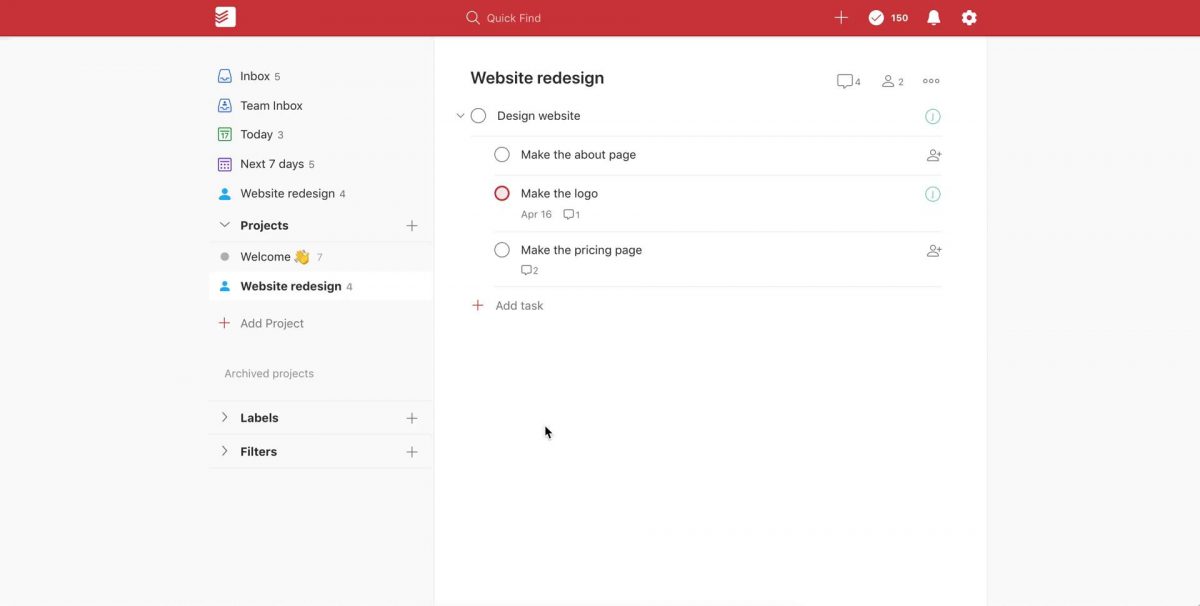
Todoist is a great project management app meant to help you create and manage your to-do lists and feel more in control of your workload. It allows you to:
- Define your tasks,
- Set deadlines and reminders,
- Add comments to your to-do items, and
- Streamline your work routine.
But if you’re looking for something more advanced, check out the following tip.
Tip #2: Use a project management tool
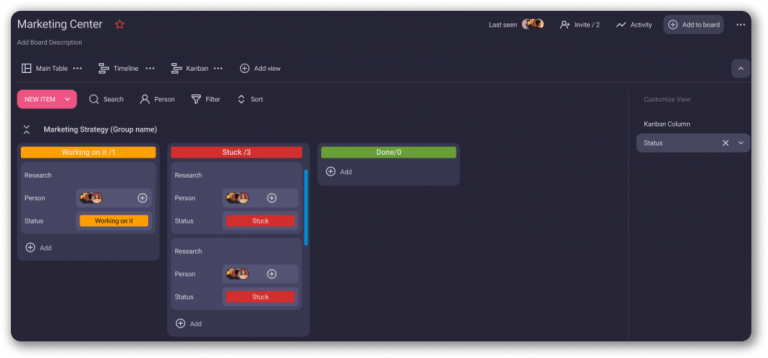
Plaky is a free and intuitive project management tool that allows you to manage:
- Tasks,
- Projects, and
- Teams timely.
Unlike many other apps that limit the number of features and users, Plaky doesn’t cap your productivity.
Most relevant for you as a freelancer, this tool allows you to create a board and set it to:
- Private,
- Public, or
- Shareable.
As a result, you can have as many or as few collaborators as you like.
Finally, Plaky helps you create a workflow that fits your needs with countless customizable fields.
Tip #3: Use a time management tool
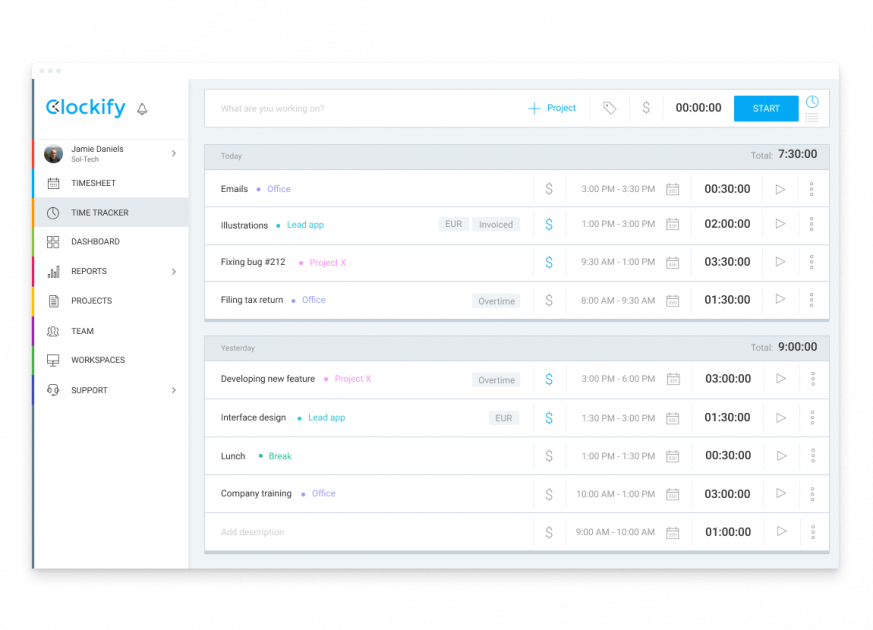
Clockify is a freelance time management software that enables you to track the time you spend on activities. With this free app, you can see how productive you really are with your projects and tasks.
Interestingly, this freelance time management app helps you track the time you spend on all work-related activities. Later, you can analyze your results to see whether you’re really productive with your time — or if you spend too much time on trivial activities or procrastinate.
Handy for freelancers, you can now schedule repeating assignments and send invoices to clients directly from Clockify. If you have the same task to do every week, you don’t have to bother inserting it every time. Similarly, you don’t have to download client reports and then send them via email. Instead, you can ship them directly in a jiffy.
Finally, you can also integrate the Clockify Chrome extension with 80+ various:
- Project management apps, like Trello and Todoist,
- Development apps, such as Jira and Github,
- Business apps, including Zendesk and Salesforce, and
- Other necessary apps, like Evernote, Google apps, etc.
This way, you’ll be able to track the time you spend on their features and really streamline your business.
For example, suppose you are working on an item from your to-do list in Todoist. In this case, you can turn on the Clockify timer directly from Todoist and track the time it takes you to check off that item.
Tip #4: Use a suitable suite of tools

The most famous of all suites, Google apps include Gmail, Google Calendar, Google Docs, Google Keep, and others, with each of their unique features automating your work.
First of all, you can manage your email correspondence with Gmail.
Secondly, Google Calendar lets you block time for your tasks and everyday activities. It’s handy because it allows you to have an hour-by-hour schedule.
Thirdly, you can write and edit things in Google Docs, and later access these documents from various devices.
Google Keep lets you take notes and set reminders for your work-related activities.
What’s more, they operate seamlessly within Google’s environment. This means that you can smoothly switch between them, enhancing your workflow and productivity.
Tips for communicating and cooperating with clients
Freelancers have to contact clients, arrange contract terms with them, decide on deadlines, and otherwise communicate and collaborate with their clientele. To make their lives even more difficult, they need to do it all on their own.
But let’s delve into a few simple ways to make it all less stressful and more enjoyable!
Tip #1: Find (the right) clients
There’s no gentle way to say this — experience trumps everything! In most cases, clients will hire professionals with mileage under their belt over newbies. But don’t let this discourage you!
After all, as a freelancer, you are your own boss. And also, everybody has to start somewhere. So, let’s begin with a few helpful tips on finding the right clients.
If you’ve already discovered your industry niche and branded your online presence, it’s time to reach out. To gain massive traction, do the following:
- Make a list of potential clients on LinkedIn and popular job markets, and
- Send soft pitches to them.
Do this for as many prospective customers as possible. The more people you reach, the greater your chances of success.
But to create the biggest impact, contact your referral network. By this, I mean your former colleagues, followers on social media, and friends (even friends of friends). Similarly, chat with other professionals from your field and ask them to keep you in mind for future opportunities.
Sooner or later, you will land a client. When you get to this stage, it’s paramount to set expectations in an airtight contract. This is especially important because some clients ask for excessive edits. To avoid that, try making it abundantly clear to them how the arrangement works.
To build rapport, it’s wise to send regular status updates. This will drive the client to share a positive word of mouth with their industry peers. As a result, you will have a sound client base in no time. Okay, perhaps not in no time. But indeed, in a matter of months — not years. That is, if you do the work and follow other advice from this article!
Tip #2: Agree on realistic deadlines
Setting deadlines may be challenging, as you have to consider your client’s wishes and your capabilities. If you rush a project due to a short deadline, you risk a low-quality result and even losing this client in the future.
To avoid losing your clients over deadlines, it’s best that you first give your client an estimate of how much time the project might take to finish. Try having a loose estimate so that you likely get it done earlier than what you’ve guessed it would take you.
This way, you’ll save yourself the stress of rushing to finish a project and be more relaxed and more likely to complete the project in the best possible way.
Tip #3: Build a communication strategy
It’s important that you retain a good relationship with your clients. In a nutshell, you do that by maintaining proper communication.
For example, you’ll probably be interacting with your clients via email. Therefore, remember that people spend a lot of time on emails without actually needing to. Hence, setting up an email strategy will help you become fast and productive with your replies.
If you need to, you can consult an app for this. For illustration, CheatSheet helps you automate inbox management with keyboard shortcuts.
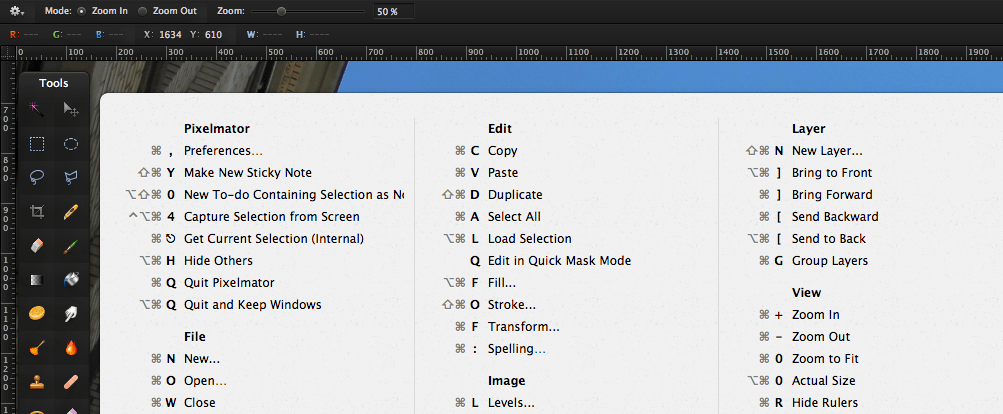
Tip #4: Learn to say “No”
Not all projects are equally important, profitable, or manageable. As a result, it’s paramount to learn when to politely decline some arrangements from time to time.
For example, it’s okay to say no when you find that you can’t finish a project within the deadline set by the client, or when you see you won’t have time to work on it.
Steve Jobs maintained the policy that “Focusing is not about saying Yes, but about saying No.”
Along similar lines, you can’t focus on your most important project when you have three average projects waiting for you. The way to resolve this conundrum? Well, avoid these three average projects by simply saying Nein, Nee, No, Não, Non — or whichever language you prefer.
Finally, prioritize your projects and consider whether you should turn down a new job so that you have time to work on a more important one.
Tip #5: Improve your writing skills
No matter the industry you’re in, you’ll need a decent grasp of writing skills. Yes, this even applies to designers, programmers, and freelancers who aren’t inextricably tied to penning something daily.
In any case, all knowledge workers operating as freelancers want to up their day-to-day productivity. Often this means improving how they interact with others on their favorite chat software, craft proposals, or compose emails.
For starters, fixing your ability to write helps you communicate effectively with your clients and coworkers. As a result, you get people excited about collaborating with you. And who doesn’t want that? Exactly my point!
To help you out with writing better, here are a few tips:
- Immerse yourself in a course on Udemy. These are as cheap as they get with the learning platform’s regular discounts.
- Practice showing up every day. Try writing a few hundred words every day! Yes, even if you don’t feel like it. Famous author of On Writing Well, William Zinsser, explains that you perfect your writing craft by showing up to do the work every day. The more you write, the better you get — and sooner.
- Use active voice. Nobody wants to read sentences like The painting will be painted by Elisabeth. Instead, write Elisabeth will paint the painting! So much better, right?
- Beware of your tone and avoid using clichés. Remain aware of what you’re writing about and for whom. In fact, you may come across as distant, confusing, or a catch-all if you don’t pay attention to detail.
Additional tips for freelancers
Your workday shouldn’t only be work-work-work. As a matter of fact, plenty of data suggests that taking a moment to reorient yields amazing results. And I can attest to that!
So, here are a few tried-and-true tactics to up your productivity game.
Tip #1: Take regular breaks
They’ll help you avoid burnout and be more productive with the time you actually spend working. In addition, regular breaks serve to refresh you and give you a different perspective after you get back to work.
Tip #2: Don’t skip meals (often)
Block some time in your calendar for breakfast, lunch, and dinner every day. But remember that some people feel better when they occasionally skip a meal. Tinker with it and see what works for you.
Tip #3: Leave time for socializing
Socialize with friends and family and leave some time for hobbies, too.
A freelancer’s schedule is flexible in terms of work hours. Still, this also means you may sometimes work more than an average full-time employee.
In that sense, you may have to check off your to-do list items on weekends or holidays. Anyhow, it’s best that you allocate the all-to-needed relaxation time to other days.
Tip #4: Prepare a random thoughts journal
In a thoughts journal, you jot down ideas that pop up — usually unrelated to work.
These can be things like grocery shopping, fantasizing about your next vacation, or just small stuff you don’t want to forget. Whatever it may be, try writing it down on a physical piece of paper. Doing so allows you to unburden the computing power you need for work.
But what is that?
Well, each person has a finite stock of attention every day and a limited capacity to process environmental conditions. Therefore, it’s imperative to use your most precious mental assets wisely.
The future of freelancing
If you’re wondering about what the future has in store for freelancers, let’s touch on it in a few paragraphs.
In any case, it’s worth keeping your eye on future tips for freelancers as our industry keeps evolving. Speaking of which, a spike in the number of freelancers will inevitably create drastic changes. Statista projects that in 2027, more than 85 million people will be freelancing in the US. In other words, they’ll make up more than 50% of the country’s workforce.
To get an expert opinion on the near and far future of freelancing, I asked Kimberley Tyler-Smith, an executive at the career tech platform Resume Worded, to share her wisdom. In a nutshell, she can’t stress enough the importance of personal branding and marketing for freelancers.

“The freelancing industry is growing at an incredible rate, but it’s also becoming increasingly competitive. When you’re competing with hundreds (or thousands) of other freelancers for a job, you need to stand out from the crowd — and standing out means ensuring you have a strong brand presence and that your marketing efforts are top-notch.
She adds her best time management tip, which is quite simple, and that’s to “work on what matters most.” Without hesitation, Kimberley suggests that you should stop doing whatever isn’t bringing in revenue or clients. She urges freelancers to be ruthless about it, asserting that “you don’t have time to be distracted by anything that isn’t directly contributing to your bottom line.”
In conclusion, Kimberley emphasizes the importance of tracking your time spent on projects. Because, she asks potently:

“If you don’t know where all those hours are going, how can you expect to change things?”
Wrapping up: Follow the freelancing tips that work for you
Tips don’t work unless they do. So, give each one a go and see what fits your personality, style, and schedule. From setting up your environment and using digital tools to taking care of your health and mind, you’ll find yourself in the sweet spot of productivity in no time.
With that said, here’s a final note to keep in mind — you don’t have to use all the tips I provided. In fact, you can focus on five or ten to start. Then, work your way up to more, if necessary.
But what’s the ultimate goal of implementing all these freelance time management tips? It’s to create more breathing space for all the other things in your life, of course!
✉️ Do you think we missed some useful time management tips and accompanying advice? If so, drop us a line at blogfeedback@clockify.me, and we’ll consider adding your thoughts to a future article. If you enjoyed reading this one, share it with someone else you know will find it helpful!
